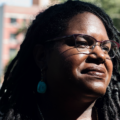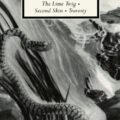Missing the Mark: Nell Zink’s Racial Fluidity

When Jess Row’s “White Flights” was published in Boston Review in 2013, nobody in the American literary world, except perhaps Jonathan Franzen, had heard of Nell Zink, an American writer from Virginia working as a translator in Germany. (Sharing a passion for birds, Zink had been corresponding with Franzen, who eventually asked to read her fiction, and then tried unsuccessfully to find a publisher for her work.) In his essay, Row examines a group of white American writers who began publishing in the 1960s. “The dominant strain of fiction by white writers in this era,” he writes, “represents what we might cynically call a massive reinvestment in white identity through the demarcation of new terrain (the exurbs) or through the reinvention of old (wilderness, urban gentrification).” By locating their fiction in specifically white spaces, in other words, these writers remove themselves from the geographic and demographic realities of America, a move which, he writes, “boxes writers into smaller and smaller spaces.”

Mislaid
by Nell Zink
Hardcover, $26.99
Ecco, 2015
Nell Zink’s latest novel, Mislaid, begins in the 1960s, the same period that Row identifies as the beginning of this literary deracination. The main character, Peggy, attempting to escape her powerful husband, discovers the birth certificate of a deceased black child, and decides that she and her blond, light-skinned daughter will pass as black while living in the deep woods of Virginia. This conceit takes advantage of the inherently absurd “one drop rule,” also known as hypodescent, in which a person with any mixed ancestry is assigned the minority (and more disadvantaged) race. In Mislaid, it prefigures the fluidity that’s imbued in the rest of the narrative. Peggy believes she is lesbian and then marries a gay man; she is born into the middle class, marries into old Southern money, and then lives in abject rural poverty, supporting herself by dealing drugs; she is white, but poses as black to avoid detection by her husband and loss of custody of her daughter Mireille.
As a single mother, poor, and black, Peggy (now Meg) is suddenly invisible to America. Yet in this space outside recognition, she also finds a truer independence, eventually achieving both love and security. The presumed safety of wealth and whiteness is revealed as being fraught with danger, perhaps specifically for women; the wild place, a space that white Americans tend to fear and largely ignore, the deep woods of the black South, offers an unexpected emotional safety. By satirizing the model that Row so eloquently identifies in his essay on the deracination of white fiction, Zink offers a more expansive vision of America than the boxed-in spaces of mainstream literary fiction.
While Mislaid showcases the racist South in all its absurdity, Zink is quite serious about her politics. In an interview with 3 am magazine, she says, “Black people were disenfranchised, robbed, driven off the land. We don’t need reparations for slavery—we need reparations for the ’50s, the ’60s, the ’70s, the ’80s, and the ’90s. I wrote Mislaid based on my own very vivid memories of the weird, unjust society of Tidewater, Virginia, with these good-old-boy assholes running everything.”
In his acclaimed book, Between The World and Me, Coates writes, “all our phrasing—race relations, racial chasm, racial justice, racial profiling, white privilege, even white supremacy—serves to obscure that racism is a visceral experience, that it dislodges brains, blocks airways, rips muscle, extracts organs, cracks bone, breaks teeth.” By setting the novel in the South from the 1960s to the 1980s, a South removed from the contemporary world and suggestive of its racist legacy, Zink’s narrative distances itself from any sense of urgency. And in doing so, her characters never inhabit that plundered black body.
Zink, as a long-term expatriate—herself, perhaps, removed from this visceral experience of America—skewers society from a remove. Mislaid’s narrative moves from one liner to bon mot to deadpan “oh yes I did say that” provocations. As a result, her one-line jokes allow the reader to laugh, often in uncomfortable recognition, but they don’t provide a space for deeper reflection. Her humor seems rooted more in moral superiority than in subversion, and therefore becomes diminishing instead of expansive, unlike, for example, John Kennedy Toole’s novel, A Confederacy of Dunces, in which the humor allows access to a complicated joy and pain of being the “other” in the South. Because of this, it doesn’t feel like much is at stake in Mislaid, whereas in Coates’s work, as in the work of authors such as Baldwin and Morrison, the black bodies portrayed are achingly at risk. Peggy and her daughter simply don and dispose of their black identities, as easily as slipping out of a silk robe. Any consequences of inhabiting a so-called black body—of bearing the socially-constructed blackness that has no root in actual biology—are easily shed once they decide to become white again.
Row’s more recent essay, “American Cynicism and Its Cure” was published in the Boston Review the same day that Nell Zink and Mislaid were profiled in The New Yorker. Less than a month later, Row and Zink’s novels, which deal with racial identity and passing, were both fortuitously back in the spotlight thanks to the real life “outing” of Rachel Dolezal, a white woman who for most of her adult life had identified and passed as black. Nell Zink was no longer invisible. In “American Cynicism and Its Cure,” Jess Row also addresses satire and cynicism as twin models of a default mode, written from a safe remove. “No longer a commitment to a new way of life, cynicism is a lifestyle, what Sloterdijk calls ‘enlightened false consciousness.’” In some way, Zink’s satirical novel embodies this enlightened false consciousness. Like the movie Harold and Maude—to borrow an example from Row’s essay—Mislaid careens from an eye-rolling cynicism to shock-and-awe satire followed by Aristotelian comedic closure. The over-the-top deux ex machina cranks out a(n) (unearned, some might argue) happy sentimental ending.
Zink’s novel certainly reads as satire, and her stated reasons for writing it (as “agent bait”) sound flippant, if not cynical—but the narrative raises questions about the depth of that satire. “In the cynical position,” Row writes, “artists feel they are allowed to say and do almost anything they want—to find almost anything funny—as long as they admit that nothing they say, no matter how outrageous, will ever have an effect on the world. And as long as they don’t cry.” While Zink claims she “pulled her punches” with Mislaid, it is also clear she enjoys her role as provocateur.
As a long-term expatriate, Zink has not hidden her contempt for American culture—its obsession with work, its third-world wage gap, its insular domestic upper-middle class fiction, the publishing industry in general. That doesn’t mean that Zink has resigned herself to inefficacy. There is a social critique, here and in the rest of Zink’s ouevre. Her two novels, for instance, seem to align with Viktor Shklovsky’s idea of defamiliarization (Shklovsky’s name is dropped on page 92 of Mislaid), in which the real world is made strange, the familiar unfamiliar. Shklovsky argues in The Theory of Prose that art should move us from recognition (automatized perception) to “seeing” an object or the world anew. He says, “The purpose of art, then, is to lead us to a knowledge of a thing through the organ of sight instead of recognition.” Zink’s intention in these earlier novels is to shock the reader in a very visceral way, to move the typical American consumer of fiction from lazy recognition to Shklovsky’s “knowledge of a thing” as only someone who has not lived there for a long time can.
The Wallcreeper was more successful, in part, because the novel teaches the reader how to read it. From the oft-quoted first sentence—“I was looking at the map when Stephen swerved, hit the rock, and occasioned the miscarriage”—to the early anal sex scene, the novel prepares the reader for deadpan humor and a female rebuttal to the idealized white male expatriate experience. The first-person voice of The Wallcreeper, moreover, allows for the narrator’s unreliability. Yet the third-person narrator of Mislaid is intrusive and elusive all at once. Deciphering the narrator’s position to the narrative, via cultural markers, is troublesome. The narrator is a faux-naïve Southerner, hung up on the past with statements like “The house had been a plantation. After the War Between the States it was turning into a school for girls…” employing the term “colored” often, remarking that the protagonist’s father “felt important all the time, because he was descended from a family that had sheltered John Wilkes Booth.” But this narrative voice shifts, moving from an identity who mocks the characters to one who seems to enjoy making them suffer, rushing them through fabricated obstacles. It is not so much a narrative voice as an authorial inflection.
Mislaid moves at a fast clip, with many scenes summarized in utilitarian language, so that the reader, breathless, feels like she is in the back seat of a car. The driver might be Maude, careening wildly through the streets. The readers are supposed to grab hold and enjoy the ride. But much of the novel reads as if it was dashed off—which, Zink claims, it was. Here is a typical example, in this paragraph in the last few pages of the novel, “Absolved of her guilt, she got up the courage to visit her parents. They were unchanged. She was floored….Between them lay an unbridgeable emotional gulf. It had been there ever since the day she told them she would grow up to be a man.”
The reader mocks the narrative voice, who mocks the characters—surely then someone is mocking the reader? Ultimately, this is a novel for Europeans, perhaps Zink’s own circle of ex-patriots specifically; its purpose is to confirm all that they’ve known and suspected about Americans, and Southerners—that much of it is racist, almost third-world, that the people are small-minded and mean. Zink writes to skewer the South, America, and, slyly, her American readers. The characters in Mislaid, stuck in the backwater South, are portrayed with a sometimes not-so-subtle contempt, and this meta-judgment, apparent in the accumulation of details, alienates the reader from the story.
Read that way, the novel exhibits the type of cynicism that Row associates with the privileged white upper-class American, though shifted onto an outsider’s perspective. More innocently, Mislaid is a conceit played for laughs, a political novel following the structure of an Aristotelian comedy that follows the rise in fortune of a sympathetic central character. In either case, the satire in Mislaid often misfires. For “whites” to admit racist actions or attitudes, or to expose racism, is not the end of the conversation on race in literature; it is just the beginning. As Row suggests, racism remains the unexamined foundation of white writers’ work. Racism is the warrant. It exists not only in the works of deracination that Row discusses, but in all literature that does not acknowledge what Coates discusses as the price of living the Dream. This is why, ultimately, Mislaid’s one-line zingers come across as low-hanging fruit rather than subversion. T.M. De Vos wrote at Drunken Boat, of the Rachel Dolezal affair, “One of the marks of privilege is the ability to put on the mask of the Other and remove—or maintain—it at will.” In the end, Zink’s novel plays racism and the South for a laugh that doesn’t grapple with the hatred, pain, and fear of living as an African American, for whom racial identity is not an escape.
About Sybil Baker
Sybil’s most recent novel Apparitions, received the IPPY Gold Medal for short fiction. She is the author of five works of fiction, which have won Eric Hoffer, Foreword, and IPPY awards. Her nonfiction work, Immigration Essays, was the 2018-2019 Read2Achieve selection for the University of Tennessee at Chattanooga and required reading for all first-year students. Her work has appeared in a variety of publications including Guernica, Electric Literature, Glimmer Train, and The Critical Flame. She was awarded two MakeWork Artist Grants and a 2017 Individual Artist’s Fellowship in nonfiction from the Tennessee Arts Commission. She is a professor of English at the University of Tennessee and Chattanooga, Director of the Meacham Writer’s Workshop, and on faculty for the Yale Writer’s Workshop.





